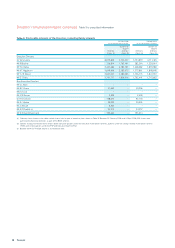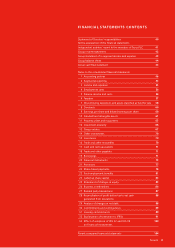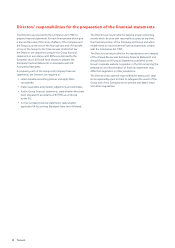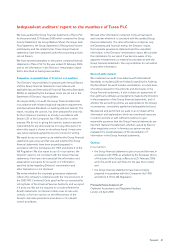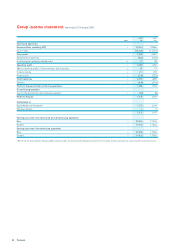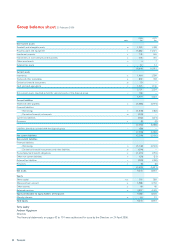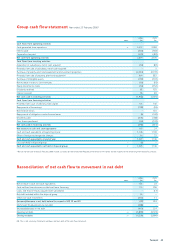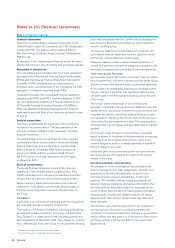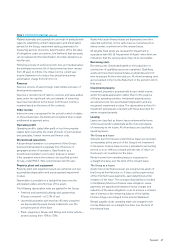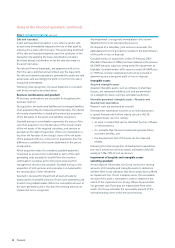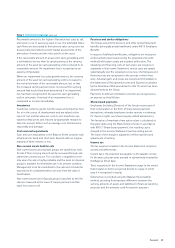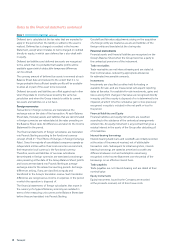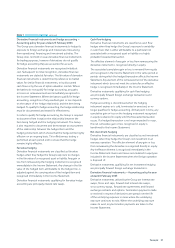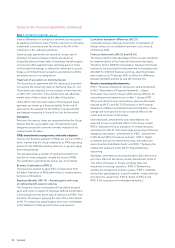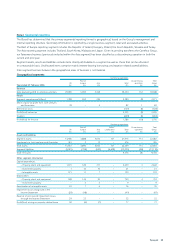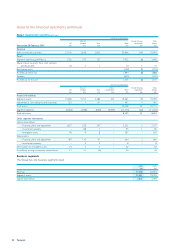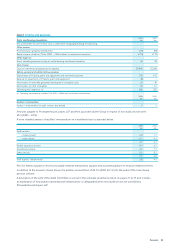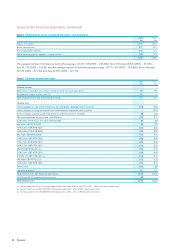Tesco 2006 Annual Report Download - page 48
Download and view the complete annual report
Please find page 48 of the 2006 Tesco annual report below. You can navigate through the pages in the report by either clicking on the pages listed below, or by using the keyword search tool below to find specific information within the annual report.
46 Tesco plc
Notes to the financial statements
General information
Tesco PLC is a public limited company incorporated in the
United Kingdom under the Companies Act 1985 (Registration
number 445790). The address of the registered office is
New Tesco House, Delamare Road, Cheshunt, Hertfordshire,
EN8 9SL, UK.
As described in the Operating and financial review, the main
activity of the Group is that of retailing and associated activities.
Statement of compliance
The consolidated financial statements have been prepared in
accordance with International Financial Reporting Standards
(IFRSs) and International Financial Reporting Interpretation
Committee (IFRIC) interpretations as endorsed by the
European Union, and those parts of the Companies Act 1985
applicable to companies reporting under IFRSs.
These are the Group’s first consolidated financial statements
prepared under IFRSs and IFRS 1 ‘First time adoption of IFRS’
has been applied. An explanation of how the transition from
UK Generally Accepted Accounting Principles (UK GAAP) to
IFRSs has affected the reported financial position, financial
performance and cash flows of the Group are provided in notes
32 and 33.
Basis of preparation
The financial statements are presented in Pounds Sterling,
rounded tothe nearest million. They are prepared on the
historical cost basis modified for the revaluation of certain
financial instruments.
The accounting policies set out below have been applied
consistently to all periods presented in these consolidated
financial statements and in preparing an opening IFRSs
BalanceSheet at 29 February 2004 for the purposes of
transition to IFRSs, with the exception of IAS 32* and
IAS 39†for which a one-year exemption has been taken,
as allowed by IFRS 1.
Basis of consolidation
The Group financial statements consist of the financial
statements of the ultimate parent Company (Tesco PLC),
entities controlled by the Company (its subsidiaries) and the
Group’sshareof interests in joint ventures and associates.
Wherenecessary, adjustments are made to the financial
statements of subsidiaries, joint ventures and associates to
bring the accounting policies used into line with those of
the Group.
Subsidiaries
A subsidiary is an entity whose operating and financing policies
are controlled, directly or indirectly, by Tesco PLC.
The accounts of the parent Company’s subsidiary undertakings
are prepared todates around the Group year end apart from
Tesco Taiwan Co. Limited, which for this reporting period have
been prepared to 31 December 2005. Tesco Taiwan Co. Limited
has a different year end to the Group as a result of the pending
asset swap transaction with the Carrefour Group; keeping the
year end as 31 December will facilitate an easier integration
into the Carrefour Group.
The financial statements of subsidiaries are included in the
consolidated financial statements from the date that control
commences until the date that control ceases.
Intragroup balances and any unrealised gains and losses or
income and expenses arising from intragroup transactions, are
eliminated in preparing the consolidated financial statements.
Joint ventures and Associates
Ajoint venture is an entity in which the Group holds an interest
on a long-term basis and which is jointly controlled by the Group
and one or more other venturers under a contractual agreement.
An associate is an undertaking, not being a subsidiary or joint
venture, over which the Group has significant influence and
can participate in the financial and operating policy decisions
of the entity.
The Group’sshareof the results of joint ventures and
associates is included in the Group Income Statement using the
equity method of accounting. Investments in joint ventures and
associates are carried in the Group Balance Sheet at cost plus
post-acquisition changes in the Group’s share of the net assets
of the entity, less any impairment in value. The carrying values
of investments in joint ventures and associates include acquired
goodwill.
If the Group’sshare of losses in a joint venture or associate
equals or exceed its investment in the joint venture or associate,
the Group does not recognise further losses, unless it has
incurred obligations to do so or made payments on behalf of
the joint ventureor associate.
Unrealised gains arising from transactions with joint ventures
and associates areeliminated tothe extent of the Group’s
interest in the entity.
Useof assumptions and estimates
The preparation of the consolidated financial statements
requires management to make judgements, estimates and
assumptions that affect the application of policies and
reported amounts of assets and liabilities, income and
expenses. The estimates and associated assumptions are
based on historical experience and various other factors that
are believed to be reasonable under the circumstances, the
results of which form the basis of making judgements about
carrying values of assets and liabilities that are not readily
apparent from other sources. Actual results may differ from
theseestimates.
The estimates and underlying assumptions are reviewed on
an ongoing basis. Revisions to accounting estimates are
recognised in the period in which the estimate is revised if the
revision affects only that period, or in the period of the revision
and future periods if the revision affects both current and
futureperiods.
*‘Financial Instruments: Disclosure and Presentation’.
†‘Financial Instruments: Recognition and measurement’.
Note 1 Accounting policies




